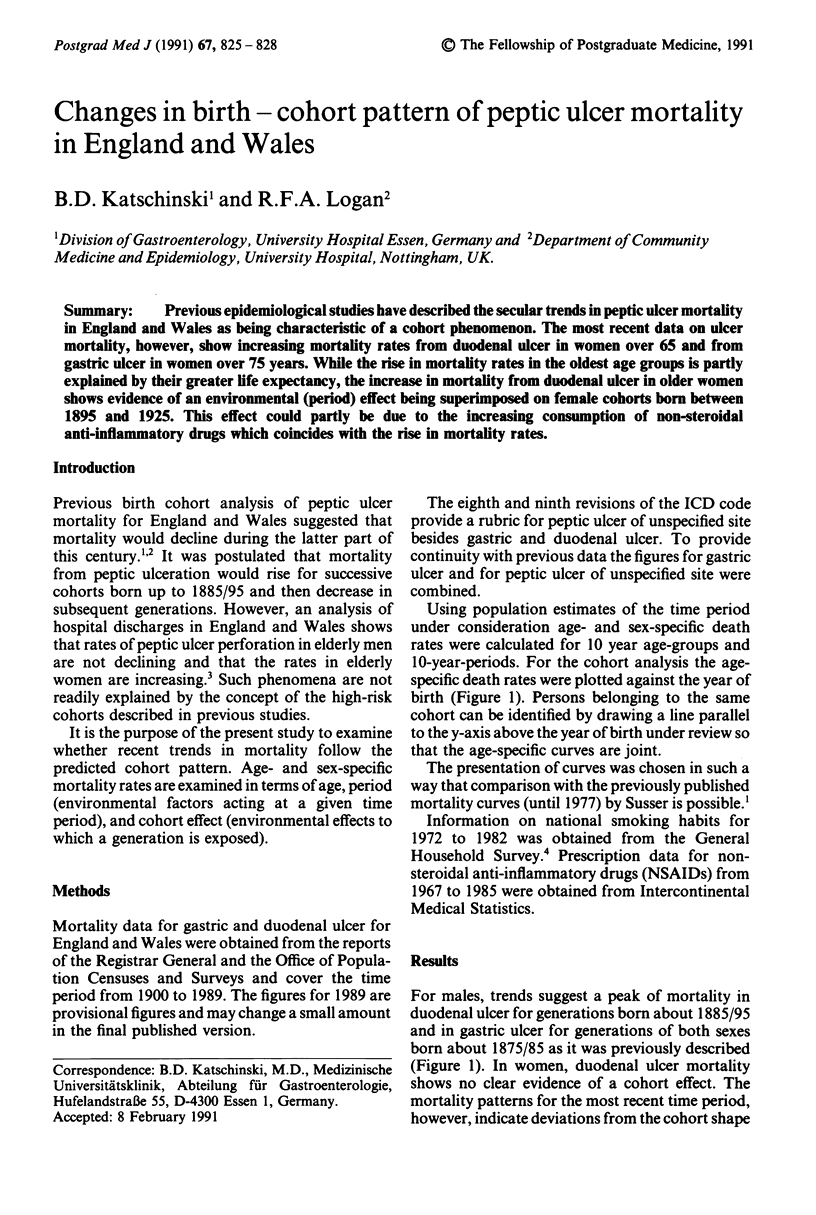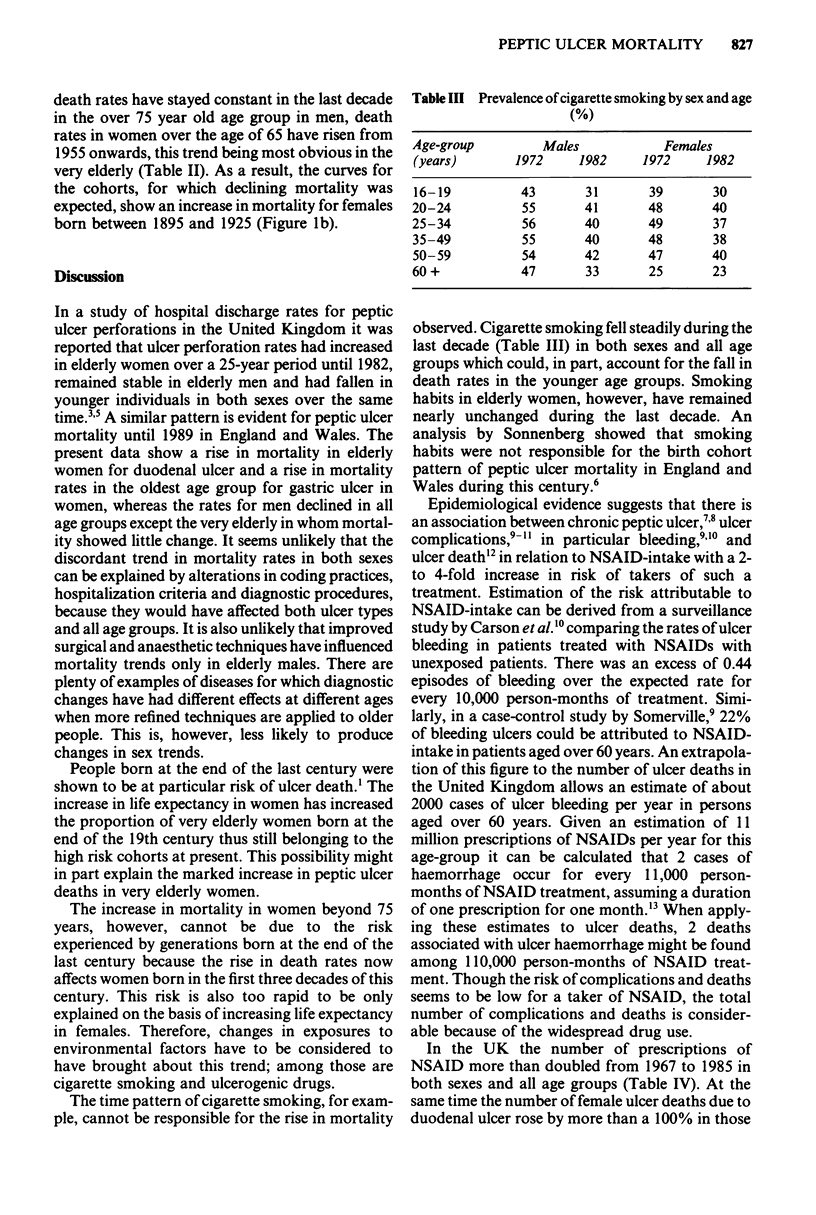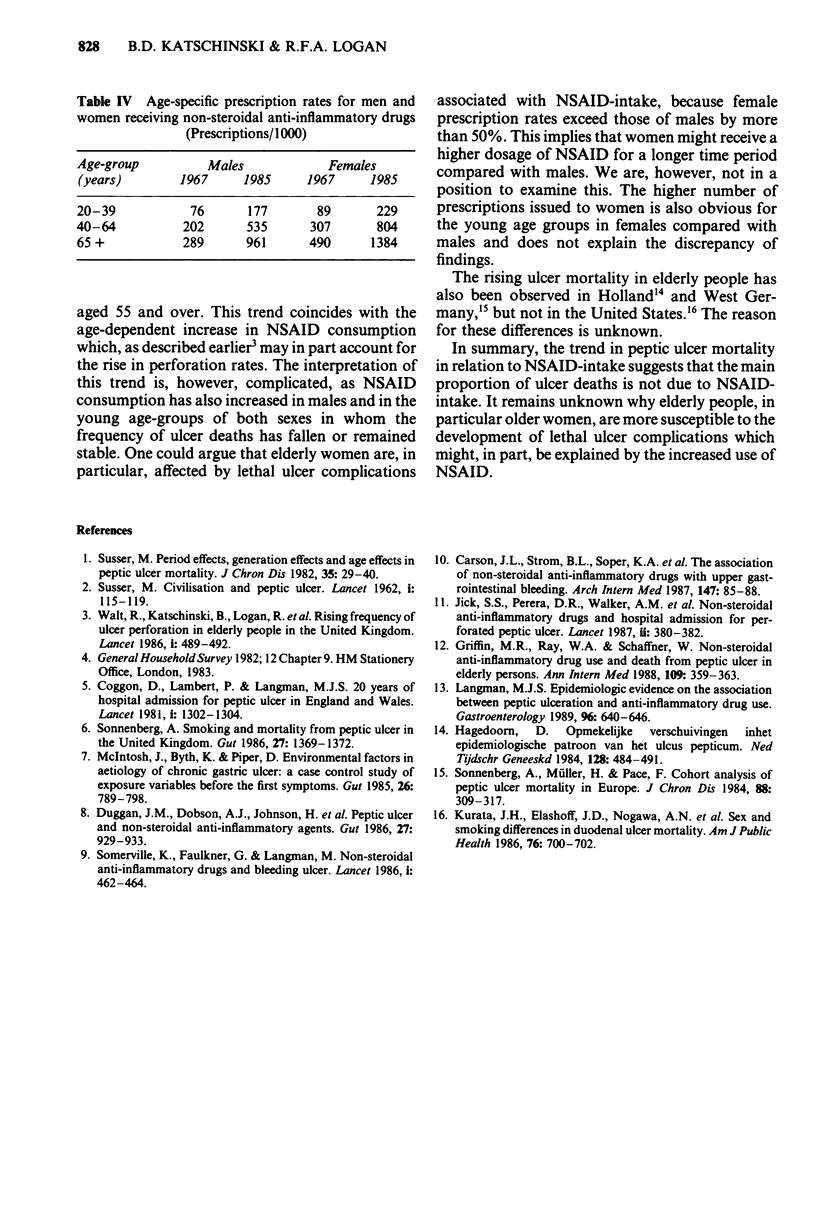Abstract
Previous epidemiological studies have described the secular trends in peptic ulcer mortality in England and Wales as being characteristic of a cohort phenomenon. The most recent data on ulcer mortality, however, show increasing mortality rates from duodenal ulcer in women over 65 and from gastric ulcer in women over 75 years. While the rise in mortality rates in the oldest age groups is partly explained by their greater life expectancy, the increase in mortality from duodenal ulcer in older women shows evidence of an environmental (period) effect being superimposed on female cohorts born between 1895 and 1925. This effect could partly be due to the increasing consumption of non-steroidal anti-inflammatory drugs which coincides with the rise in mortality rates.
Full text
PDF



Selected References
These references are in PubMed. This may not be the complete list of references from this article.
- Carson J. L., Strom B. L., Soper K. A., West S. L., Morse M. L. The association of nonsteroidal anti-inflammatory drugs with upper gastrointestinal tract bleeding. Arch Intern Med. 1987 Jan;147(1):85–88. [PubMed] [Google Scholar]
- Coggon D., Lambert P., Langman M. J. 20 years of hospital admissions for peptic ulcer in England and Wales. Lancet. 1981 Jun 13;1(8233):1302–1304. doi: 10.1016/s0140-6736(81)92470-3. [DOI] [PubMed] [Google Scholar]
- Duggan J. M., Dobson A. J., Johnson H., Fahey P. Peptic ulcer and non-steroidal anti-inflammatory agents. Gut. 1986 Aug;27(8):929–933. doi: 10.1136/gut.27.8.929. [DOI] [PMC free article] [PubMed] [Google Scholar]
- Griffin M. R., Ray W. A., Schaffner W. Nonsteroidal anti-inflammatory drug use and death from peptic ulcer in elderly persons. Ann Intern Med. 1988 Sep 1;109(5):359–363. doi: 10.7326/0003-4819-109-5-359. [DOI] [PubMed] [Google Scholar]
- Jick S. S., Perera D. R., Walker A. M., Jick H. Non-steroidal anti-inflammatory drugs and hospital admission for perforated peptic ulcer. Lancet. 1987 Aug 15;2(8555):380–382. doi: 10.1016/s0140-6736(87)92393-2. [DOI] [PubMed] [Google Scholar]
- Kurata J. H., Elashoff J. D., Nogawa A. N., Haile B. M. Sex and smoking differences in duodenal ulcer mortality. Am J Public Health. 1986 Jun;76(6):700–702. doi: 10.2105/ajph.76.6.700. [DOI] [PMC free article] [PubMed] [Google Scholar]
- Langman M. J. Epidemiologic evidence on the association between peptic ulceration and antiinflammatory drug use. Gastroenterology. 1989 Feb;96(2 Pt 2 Suppl):640–646. doi: 10.1016/s0016-5085(89)80060-5. [DOI] [PubMed] [Google Scholar]
- McIntosh J. H., Byth K., Piper D. W. Environmental factors in aetiology of chronic gastric ulcer: a case control study of exposure variables before the first symptoms. Gut. 1985 Aug;26(8):789–798. doi: 10.1136/gut.26.8.789. [DOI] [PMC free article] [PubMed] [Google Scholar]
- Somerville K., Faulkner G., Langman M. Non-steroidal anti-inflammatory drugs and bleeding peptic ulcer. Lancet. 1986 Mar 1;1(8479):462–464. doi: 10.1016/s0140-6736(86)92927-2. [DOI] [PubMed] [Google Scholar]
- Sonnenberg A. Smoking and mortality from peptic ulcer in the United Kingdom. Gut. 1986 Nov;27(11):1369–1372. doi: 10.1136/gut.27.11.1369. [DOI] [PMC free article] [PubMed] [Google Scholar]
- Susser M. Period effects, generation effects and age effects in peptic ulcer mortality. J Chronic Dis. 1982;35(1):29–40. doi: 10.1016/0021-9681(82)90027-3. [DOI] [PubMed] [Google Scholar]
- Walt R., Katschinski B., Logan R., Ashley J., Langman M. Rising frequency of ulcer perforation in elderly people in the United Kingdom. Lancet. 1986 Mar 1;1(8479):489–492. doi: 10.1016/s0140-6736(86)92940-5. [DOI] [PubMed] [Google Scholar]


